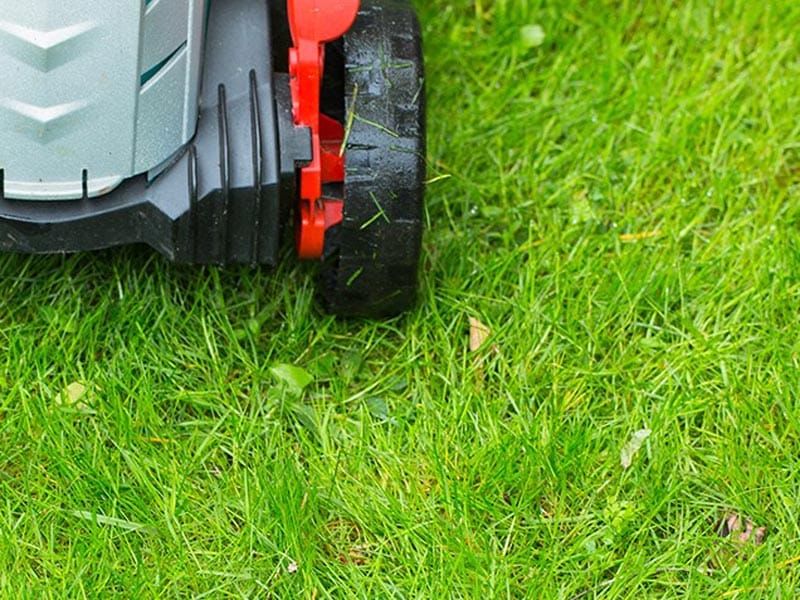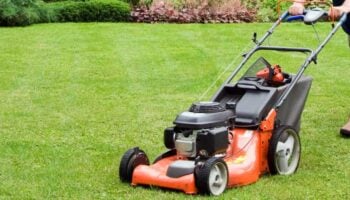Have you ever spent a decent amount of time on your day mowing your lawn, looking over it when you’re all done, and wondering if you actually mowed at all?
Yes, it’s something that should never happen but does every once and a while. But one thing you’re sure of is the mower does work. It has power. You didn’t just push the mower around the lawn silently and think you actually mowed.
Let’s assume you’ve eliminated all of that as a possibility.
So, why does the grass look like it’s only a little shorter if not the same exact height?
Lucky for you, we’ve got a couple of reasons below that may explain the issue with your mowing height and how you can get it cut lower.
1. Is Your Grass Wet?
Wait a minute. This isn’t the question you wanted an answer to. You wanted to know why your mower isn’t cutting low enough.
Well, to answer that question, let’s first take a look at the actual condition of your grass. The first condition to examine is whether it’s wet or dry.
It’s a good question to ask because the grass will cut a lot differently when it’s wet compared to when it’s dry. If you’re doubting this, think of wet hair. It’s always easier to comb when it’s wet, right? But unless you put some product in there, what tends to happen to hair as it dries?

That’s right, it doesn’t stay in the exact same place as when it was wet. It’s not as heavy because it’s no longer absorbing moisture. And as it dries, it tends to stick up, maybe become puffier, depending on your genetics.
The same goes for a lawn. Grass that is wet, and maybe taller than normal, will lay down easier as it’s rolled over by a mower.
You’re essentially pushing the grass down as you mow, rather than cutting the way you’re expecting. Then, when the grass dries, it sticks back up and you wonder if you ever mowed at all.
So, tip number one is don’t mow when the grass is wet. Wait until it dries and see how the grass height looks after a couple of passes with the mower.
2. Adjust Your Mower’s Wheels
You might think this should have been the first tip. However, since wet conditions are also a big safety concern, it seemed like the best one to do first.
Once again, don’t mow wet grass.
Okay, moving on.
Of course, one of the easiest things to address when it comes to how low your mower is cutting is to adjust the wheel height. Sounds simple enough and, the great thing is, it is.
Each of your mower’s wheels should have its own independent height adjuster if it’s gas powered. If it’s an electric mower, there is usually one height adjuster on the rear of the mower. This adjusts the rear wheels while also adjusting the angle of the mower deck at the same time.
Side note: Many electric mowers tend to have a mower deck that’s always angled down more at the front to allow less air flow and debris under the mower deck during operation. Remember, electric mowers don’t necessarily have the rugged power of a gas mower when it comes to taking a beating.
Take a look at the wheels and make sure they’re all set to the same height to avoid making your lawn look like a series of grass step terraces.
Unless that’s the look you’re going for.
Before you hold your hands up and say you never adjust the height of your wheels, take a look at them anyway. Maybe you’ve never adjusted their heights but have you recently let someone else mow or borrow your mower? Do you have gremlins in your garage that like to play pranks on you?
In all seriousness, it won’t hurt to check the wheels’ heights and adjust them lower if you can. Problem solved, right?
Unless they’re already set low and you’re still not getting low-cut grass. In that case, it’s time to…
3. Inspect the Mower Blade and Deck
Yes, it’s come to this. Time to inspect the mower blade and deck for damage. Believe it or not, it doesn’t take much damage to affect how well your mower performs.
In this case, damage can impact more than grass height. Damage can do all kinds of interesting things to the quality of your cutting. It can cut unevenly, leave odd patterns on your lawn, or even take out big chunks of turf.
If you don’t see any damage when inspecting the blades and mower deck, check to make sure both are tight and secured the way the manufacturer recommends. Also, look for anything around the blades that might impede or impact its designed rotation. This could be things like clumps of grass or other debris.
The main thing here is to look for anything that would affect the overall mowing efficiency of your equipment, which includes not cutting at the height it should be.
If you do find damage, replace the items that are damaged. If you find debris, clear it out. Once you’re done with either or both, perform an operational check and see how the mower’s cutting height is now.
If you want to get any replacement part – or see how much one would cost – click to enter your model number in the search bar below. Our partners at AppliancePartsPros stock almost every part with free guides on how to install them.

4. Are You Using the Same Mowing Pattern?
This may sound like an odd question but are you a creature of habit that prefers to mow their yard the same way every time? In other words, do you go in the same direction across your lawn each time you mow?
If you do, you’re encouraging the grass to grow at the same angles after each mow. This can lead to the grass also bending to the mower, if you will, each time you mow.
To put it another way, if you shave with the grain, you’ll never remove as much hair as if you shave against the grain.
So, for your lawn, try to change the direction you mow at least every other time. If you go one way, reverse it and go the other the next time. This will actually improve growth quality and ensure you’re getting the height you’re looking for.

5. Is Your Grass Really Tall?
Your grass doesn’t have to be forbidden jungle tall. More than a few inches taller than what you might consider normal is enough.
If it is tall as described, did you have your mower set at a short height and try to plow into the grass, hoping to cut it all down in one session?
This is a course of action that is not advised. Why?
Well, it’s kind of the reason it’s a bad idea to mow wet grass. With tall grass, you’re trying to get your mower to cut more volume at the same rate it would with shorter grass. By increasing the volume of grass the blades have to contend with, you can overload your mower, cause poor-quality cuts, and stall your mower out altogether.
If this is the case, then yes, you won’t cut low enough with the expected efficiency as you want.
The better approach to mowing tall grass is to do it over multiple days with your mower set at various heights. For the first day, start with a higher blade setting, mow the lawn, and then let it rest. Come back a day or two later, lower the blade setting a little, and mow again. Repeat another day or two later with a lower height.
Doing it this way is like a barber slowly cutting your long hair rather than hitting you with the razor from the get-go. This promotes a healthier cut for your lawn, as well, as allowing the grass to recover better. It also prevents premature dry-out compared to if you went too short right away.
Conclusion
Lawnmowers should cut at the height they’re expected to cut based on their design and the design features they’re built with. However, there are several things that can impact the actual height your grass ends up at.
Thankfully, there are also ways to correct those things so you’re getting the height you want without too much trouble.








